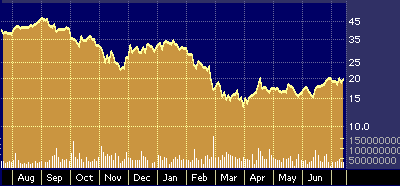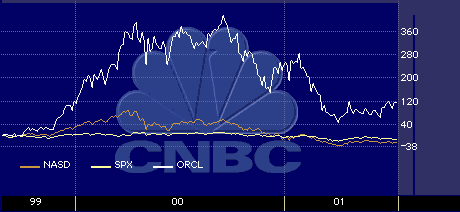
Is Oracle’s E-Biz Presence Overstated?
Is Oracle’s E-Biz Presence Overstated?
By Hal Plotkin
Silicon Valley Correspondent
If you have been paying attention to Oracle Corp.’s {ORCL} hard-to-miss advertising campaign, you probably figure that the software giant’s leap into e-business justifies its lofty valuation. After all, even the squirrels in Central Park have by now heard Oracle’s oft-stated claim to be the “world’s largest provider of software for e-business,” a boast that is supported by Oracle’s many magazine ads and roadside billboards, which flatly state that “96% of the Fortune e-50 run Oracle.”
Sounds like the company is already a well-established, big league online player, no?
What Oracle isn’t telling you, however, is that while Oracle does business with the companies on Fortune’s list, most of those relationships involve sales of the company’s older database products, rather than anything having to do with e-commerce.
In fact, Oracle continues to generate an estimated 70% of total revenue from its core database business, which has come under increasing pressure, and won’t even disclose the names of firms that have bought its highly vaunted e-business-related software, despite all the high-pitched touting of those sales to growth-minded Internet-sector investors.
“There’s no doubt the advertising is designed primarily to keep the stock price high, not sell products,” says Carl Lenz, B2B analyst at the Gartner Group in Bridgeport, Conn. “Yeah, Oracle has those customers all right, but they’re buying database software.”
That is why some analysts say the stock’s current valuation leaves considerable downside potential if the company’s ambitious plans to open new lines of e-business falter.

Oracle 52-week stock performance
Throw in the questions that have recently arisen about whether e-business firms with more customer wins, such as BEA Systems Inc. {BEAS} and i2 Technologies Inc. {ITWO} deserve their valuations, and you have to really wonder about Oracle’s valuation.
Story Link: Leading B2Bs May Be Heading for a Fall by Hal Plotkin
The stock could be worth half its current price, or even less, if and when investors understand that Oracle mostly remains what Oracle has traditionally been, a database provider.

Oracle two-year stock performance against
Nasdaq Composite and S&P 500
Oracle’s public head-feint about its business is one of the reasons Robertson Stephens analyst Eric Upin downgraded the company’s stock to “long-term attractive” from “buy” earlier this month.
“Long-term attractive” might still sound good. But it isn’t. At least, not after you talk to Upin.
While most financial analysts are still quite keen on the stock, Upin says Oracle is likely to disappoint investors over the next few quarters as the company tries to reposition itself away from its heavy reliance on database markets and toward the as-yet-unproven online-business areas it has targeted for future growth.
“Oracle is in transition,” Upin says. “Even at today’s price, you have a company that is growing the top line at maybe 17% to 20%. It would really have to be growing at 50% to 100% higher to justify its [current] valuation.”
That is, assuming Oracle can keep its growth on track, which could be a problem, at least over the next few quarters.
In addition to Upin, several other leading industry analysts, including Tim Bajarin of Creative Strategies Inc. in Campbell, Calif., and Carl Lenz, of Dataquest, say that Oracle is facing significant challenges from all sides and has yet to show it has the products or strategies needed to fend off those assaults.
For starters, there is no end to the number of competitors in the e-business software infrastructure market that beat Oracle to the punch in landing the biggest e-business accounts with many of Oracle’s database customers.
There are the well-established large competitors such as International Business Machines Corp.’s {IBM} global-services unit, for example, as well as many other soup-to-nuts e-commerce players that also have a head start on Oracle, such as Art Technology Group Inc. {ARTG} and BroadVison Inc. {BVSN}.
Perhaps more telling, however, is growing competition from the likes of application service provider start-ups, such as Silicon Valley-based Upshot.com and Salesforce.com Inc., based in San Francisco.
Story Link: Upshot Presents Problems for Oracle
ASPs are businesses that allow other businesses to buy whatever software they might need on a pay-as-you go basis. Instead of keeping the data in-house, customers usually use a Web browser or some other easy-to-use software to access whatever information they need, which is stored by the ASP.
Oracle has responded to the threat posed by ASPs by moving to become an ASP itself. But in the meantime, the company is finding itself cut off at the pass by firms that embraced the lower-cost model first.
“You have a situation where a $1 million application can rather quickly become a low-cost commodity,” Lenz says.
Oracle’s troubles don’t stop there.
The company is also facing a renewed assault on its core database business from IBM, which has run ads targeting Oracle in trade publications that are aimed squarely at corporate information technology buyers, rather than investors.
The irony here is that Oracle’s move toward selling online applications now makes it a competitor with many of the already existing e-business infrastructure suppliers, all of which also need database software to make their own products work.
“Oracle is creating an incentive for many of the big e-business players to look elsewhere for their database needs,” Upin says. “No one wants to buy products from a competitor if they can help it, and IBM is not competing in the [online] applications market so it’s looking more and more attractive.”
Oracle’s founder Larry Ellison recently responded with characteristic bravado, offering to pay anyone $1 million if they could prove that Web sites using Oracle’s latest product, called Oracle 9i, weren’t three times faster than Web sites that use competing products from IBM or Microsoft Corp. {MSFT}.
But Upin says the products don’t need to be three times faster. They just need to be fast enough to get the job done. What’s more, he says, they also have to justify themselves in terms of the costs involved in implementing them, and in terms of the speed with which they can be deployed.
To be sure, no one is counting Ellison or Oracle out at this still early stage of the fast moving e-commerce game. Oracle has, for example, made significant investments in a number of Internet and next-generation media start-up companies, such as Liberate Technologies Inc. {LBRT}, that could still pay off quite handsomely down the line.
“Ellison’s a brilliant guy, and you certainty can’t underestimate what he or his people can do when they put their minds to something,” Bajarin says.
The bigger point, however, is that the really heavy lifting, at least as far as tapping the emerging e-commerce opportunity goes, is still very much ahead of the company.
And that probably isn’t a message you are going to see on an Oracle billboard anytime soon.
Oracle, by the way, didn’t return phone calls seeking comment.


